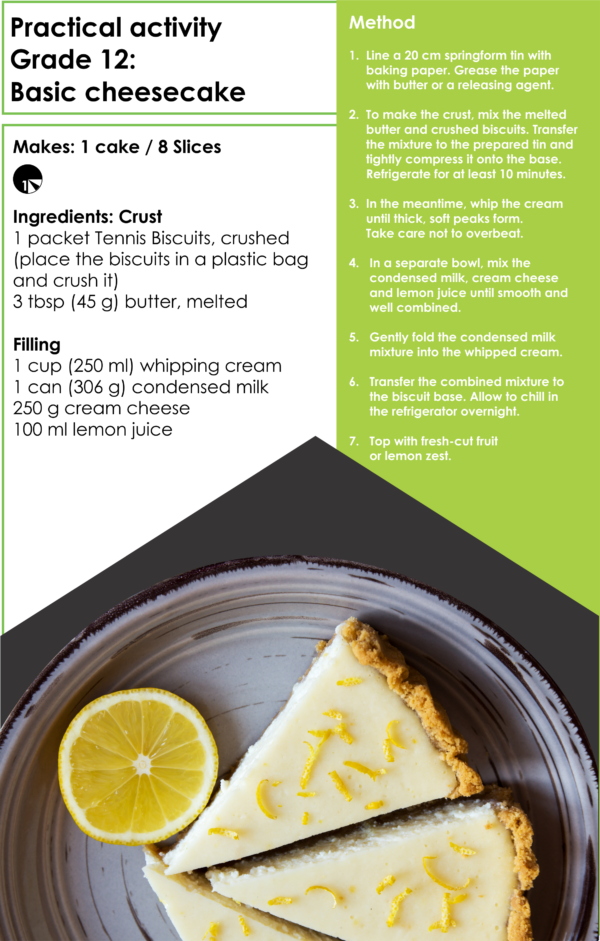
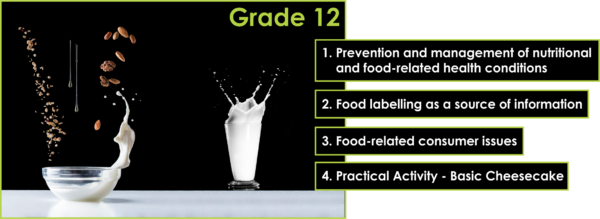
1. Prevention and management of nutritional and food-related health conditions: Milk is legend-dairy!
1.1 Introduction
The nutrients in milk contribute to good health throughout life. Milk and dairy are not only the best food sources of calcium but also nutrient-dense foods, which are important to include in a healthy, balanced diet.
Research has shown that the nutrients in milk and dairy help to:
- build strong bones and healthy teeth
- protect us against many lifestyle diseases, including heart disease and high blood pressure
- keep body weight in check.
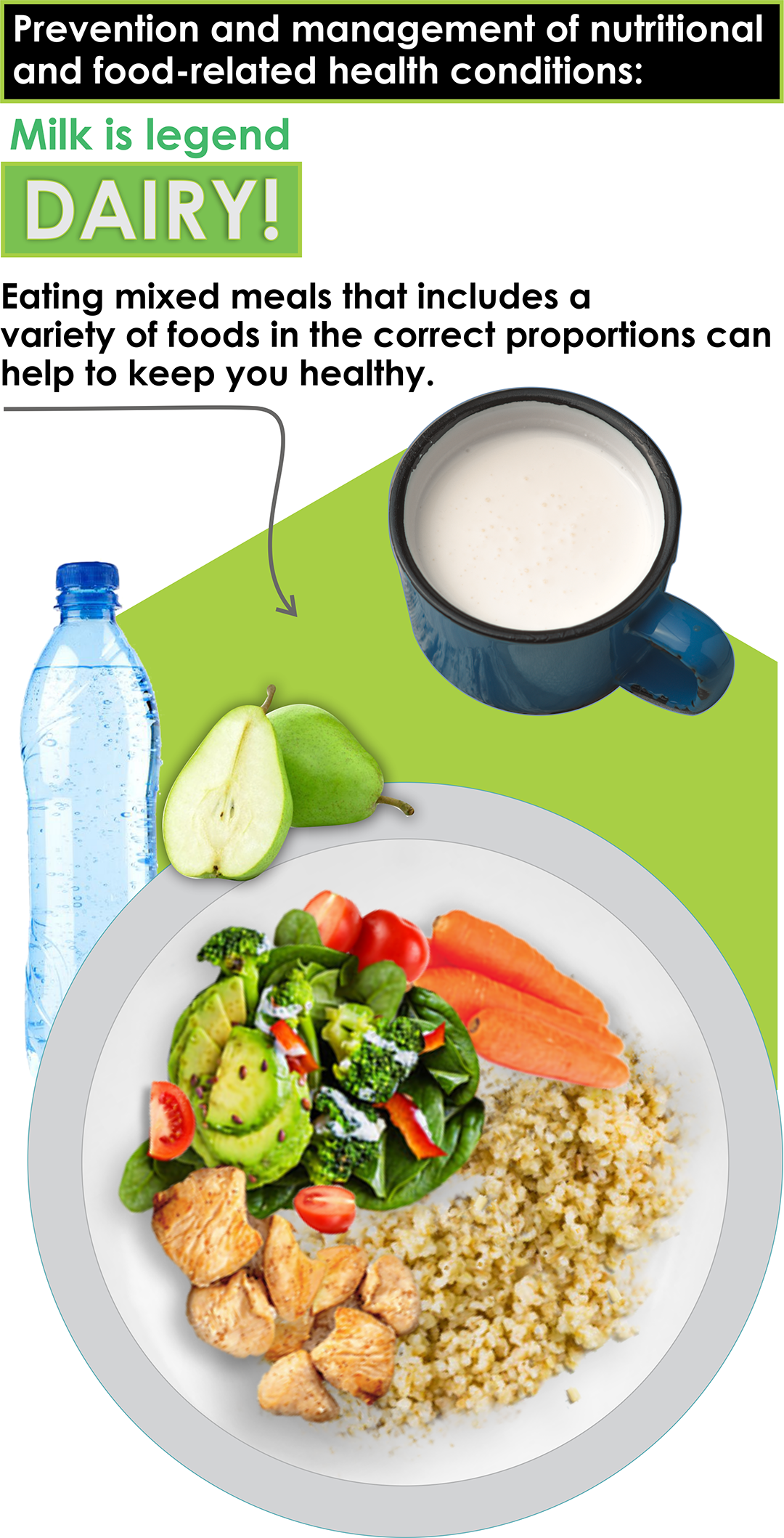
Remember to drink ample clean, safe water.
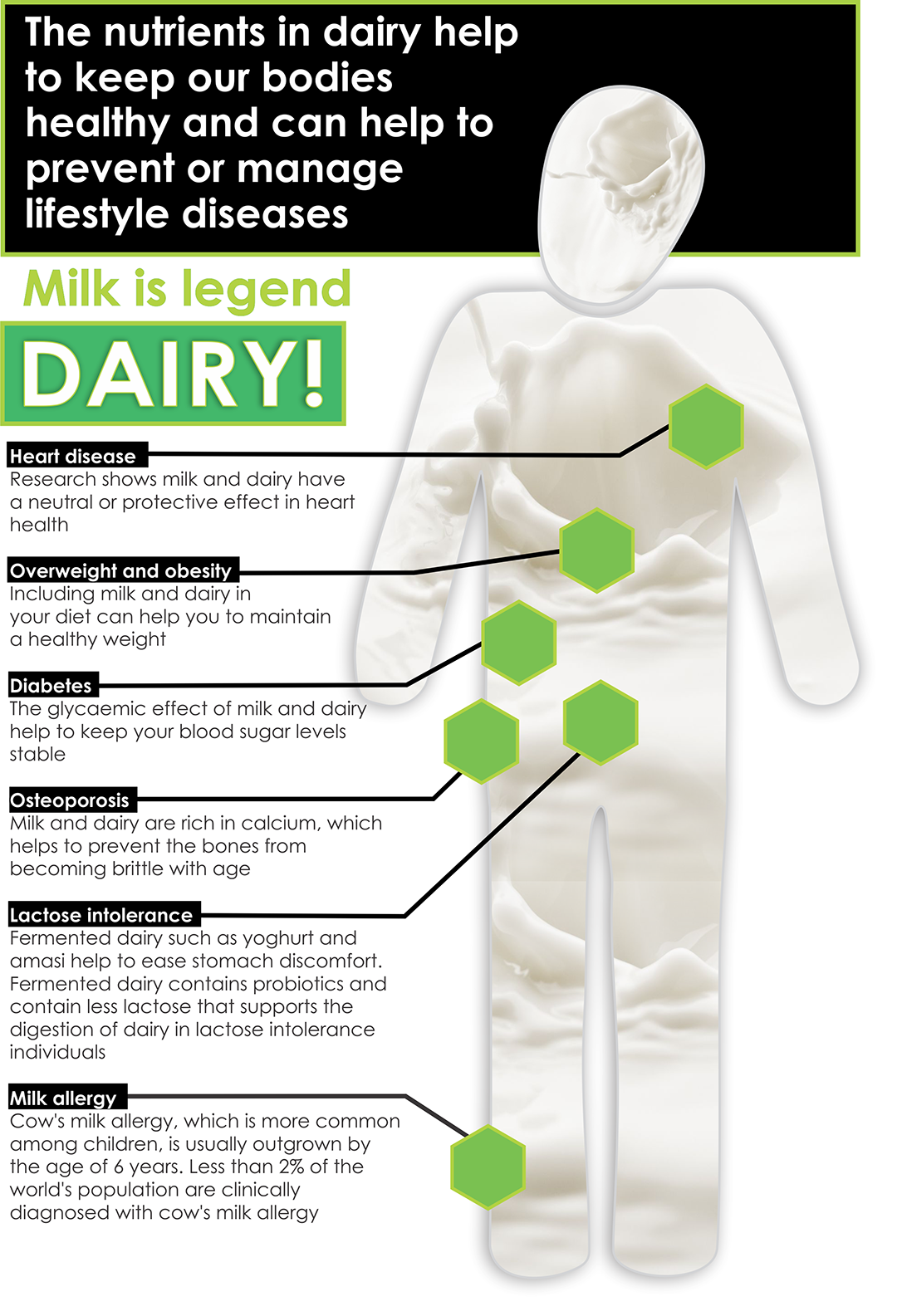
1.2 Health conditions such as osteoporosis
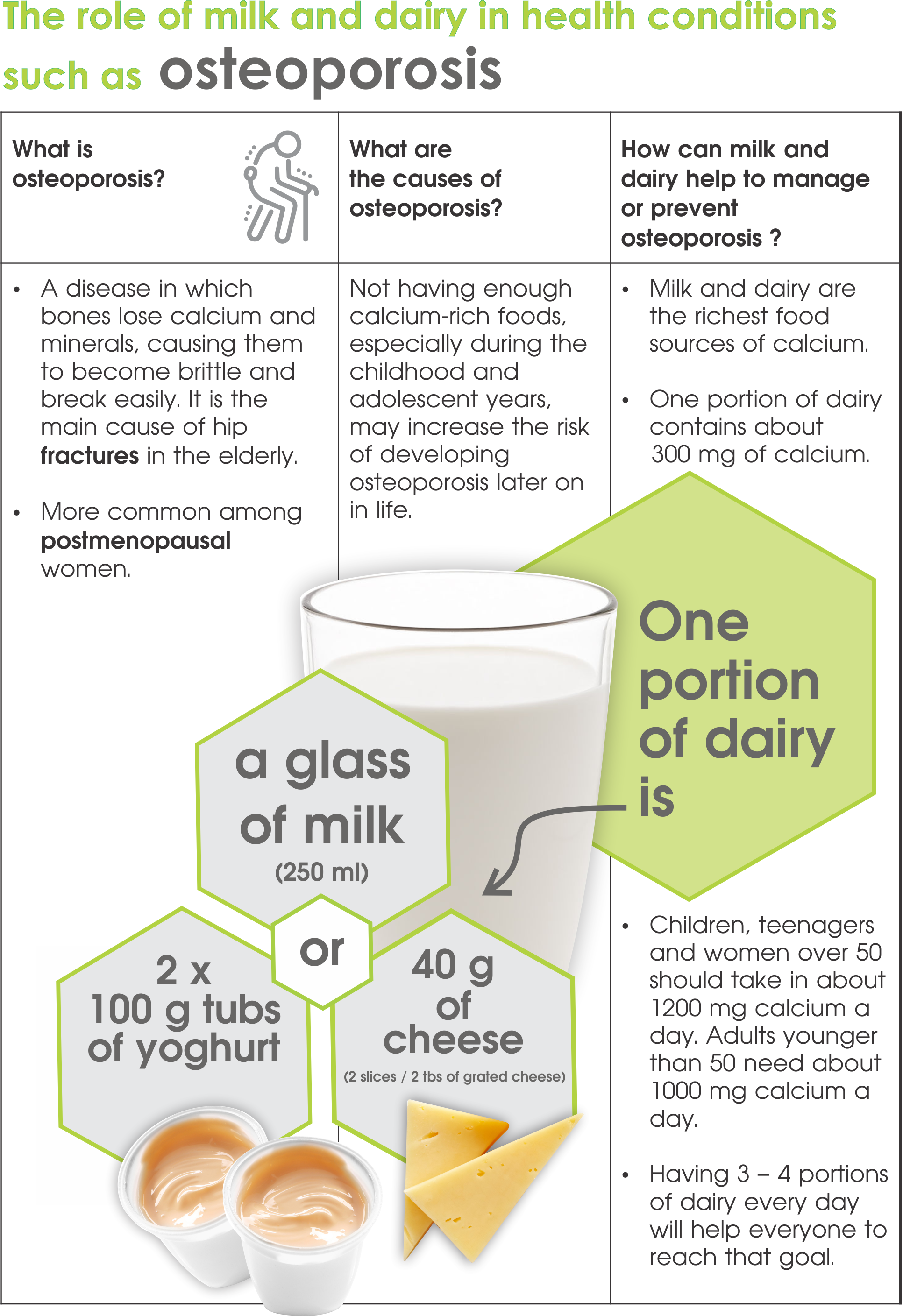
1.3 Health conditions such as overweight and obesity
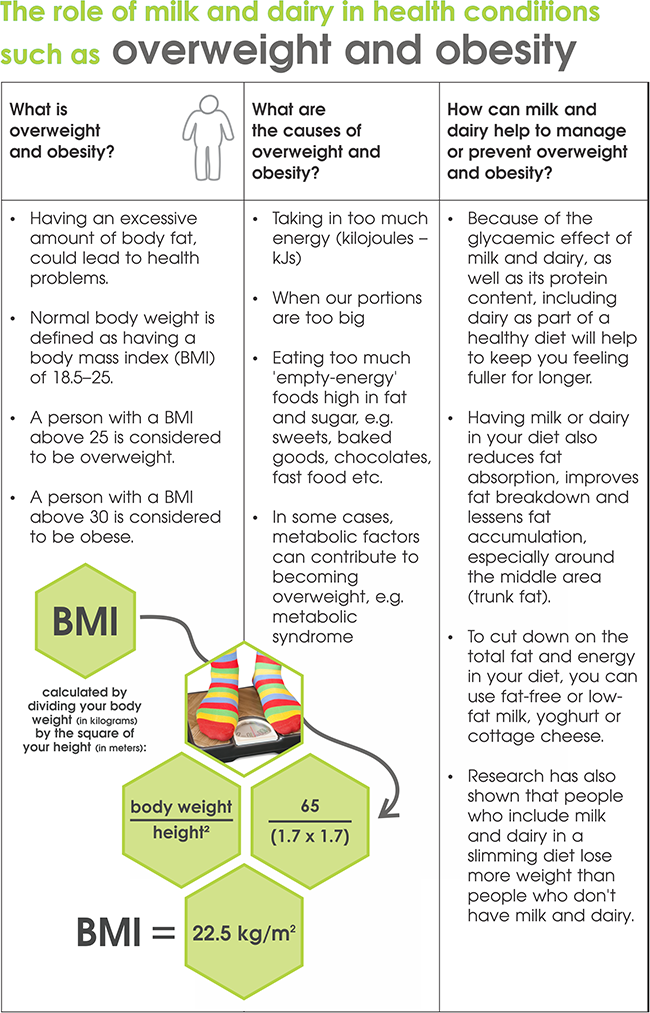
1.4 Health conditions such as coronary heart disease
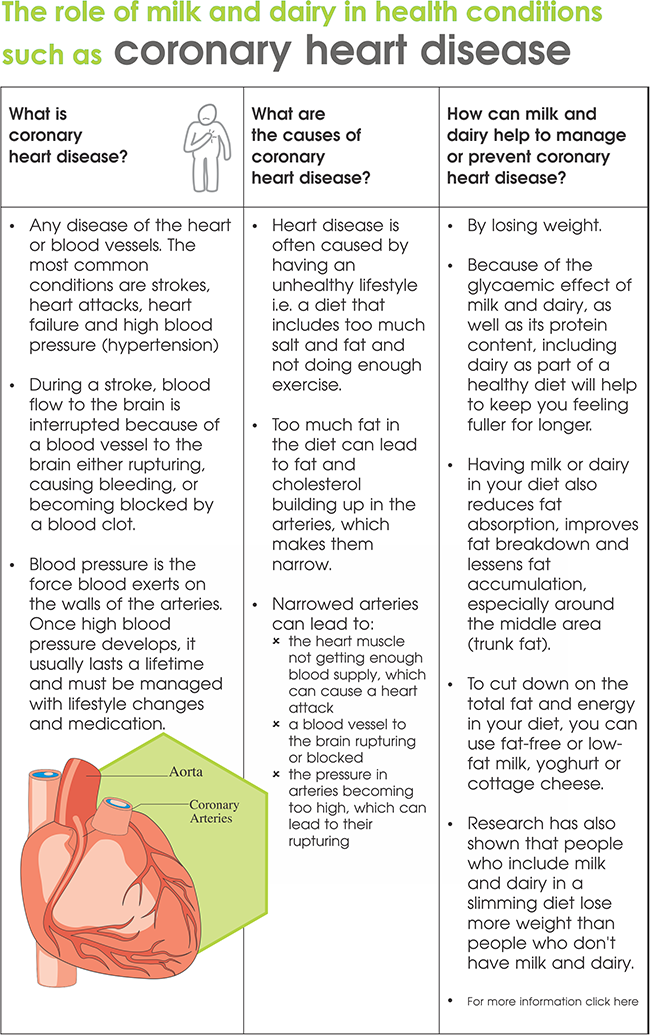
1.5 Health conditions such as diabetes
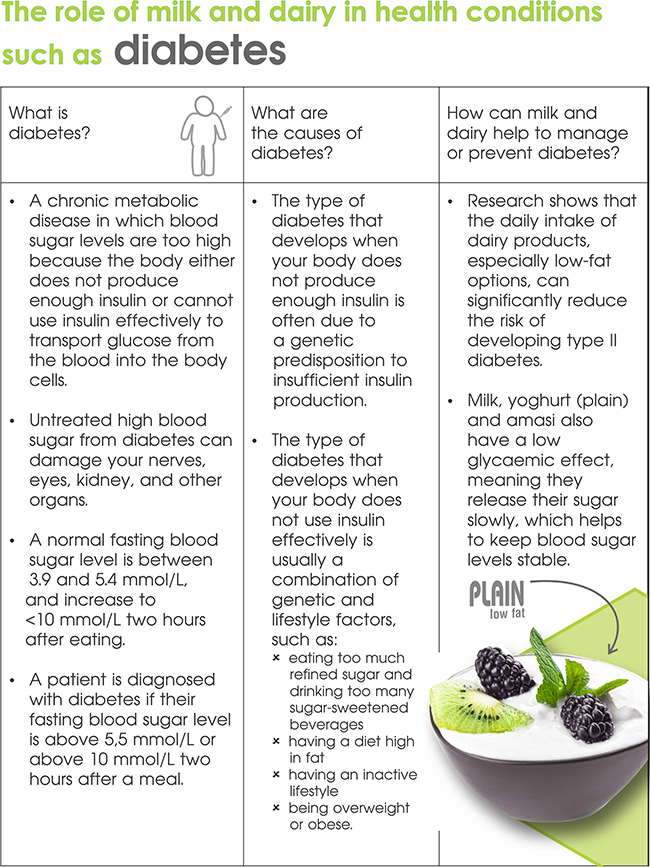
1.6 Health conditions such as lactose intolerance
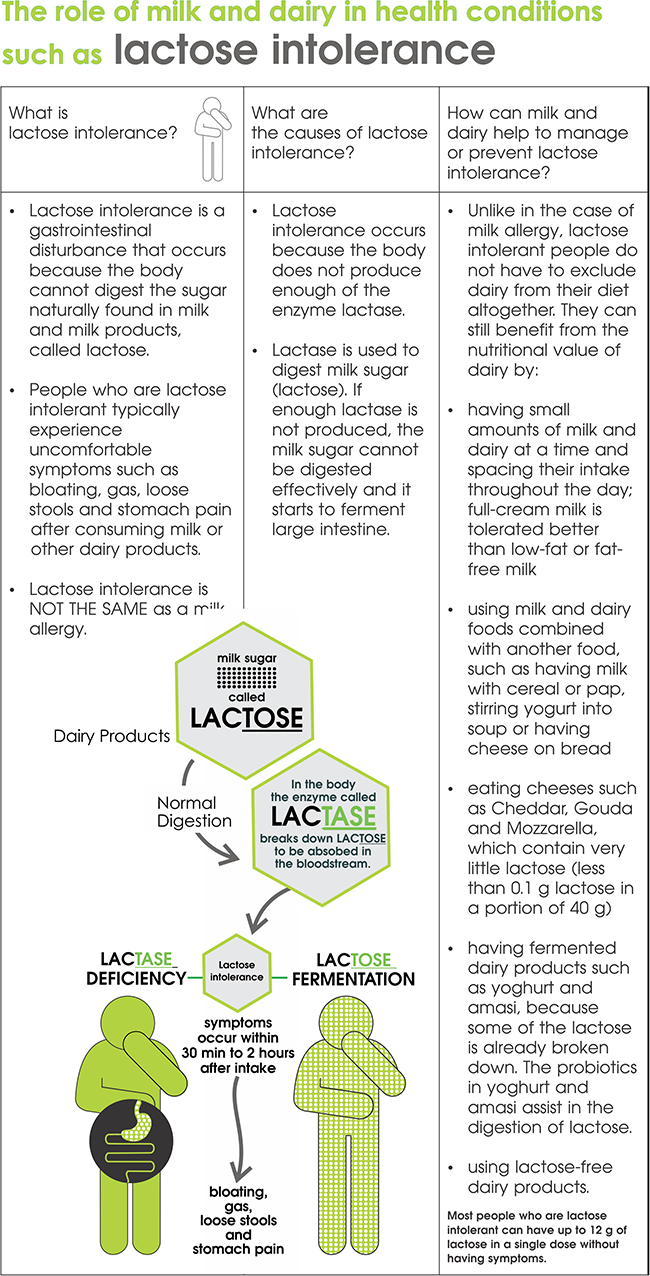
1.7 Glossary
fractures: broken bones
postmenopausal: refers to the stage in a woman’s life when she no longer menstruates
‘empty-energy’ foods: food that contain a lot of energy but we other nutrients
glycaemic effect: the effect of a food on keeping blood sugar levels stable
matrix effect of dairy: the effect of nutrients in dairy working together to bring about health benefits
insulin: a hormone produced by the pancreas that regulates blood sugar levels
lactose: the sugar naturally found in milk; also called milk sugar
lactase: the enzyme produced by the body to digest lactose (milk sugar)
ferment: undergoing a chemical change in which sugar is broken down in the absence of oxygen, producing carbon dioxide as one of the metabolic products
2. Food labels: A valuable source of consumer information.
2.1 Introduction
Reading food labels helps consumers to make informed food choices. It is often the first interaction with the product that you think of buying. In South Africa, legal regulations determine what type of information should be shown on a food label and how it should be phrased. The regulations ensures that consumer get accurate information about the food they buy and protect them against false claims. Food manufacturers have to adhere to these regulations by law.
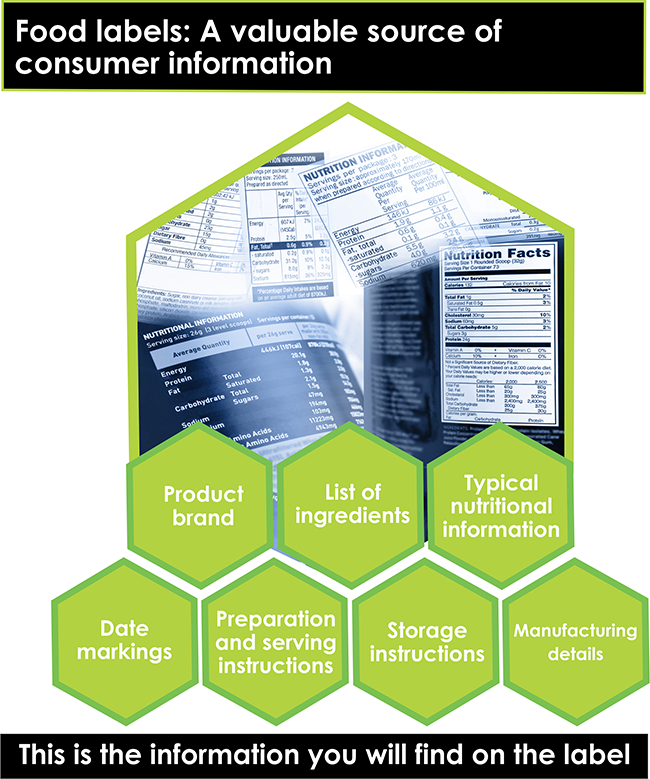
2.3 What is a food label?
A food label is the information about the product shown on its packaging. It tells the consumer about:
- the product brand, such as the product’s name and logo and the manufacturer’s details
- the product’s nutritional composition, such as ingredients and nutritional value
- safe use of the product, such as storage instructions, preparation instructions and expiration dates.
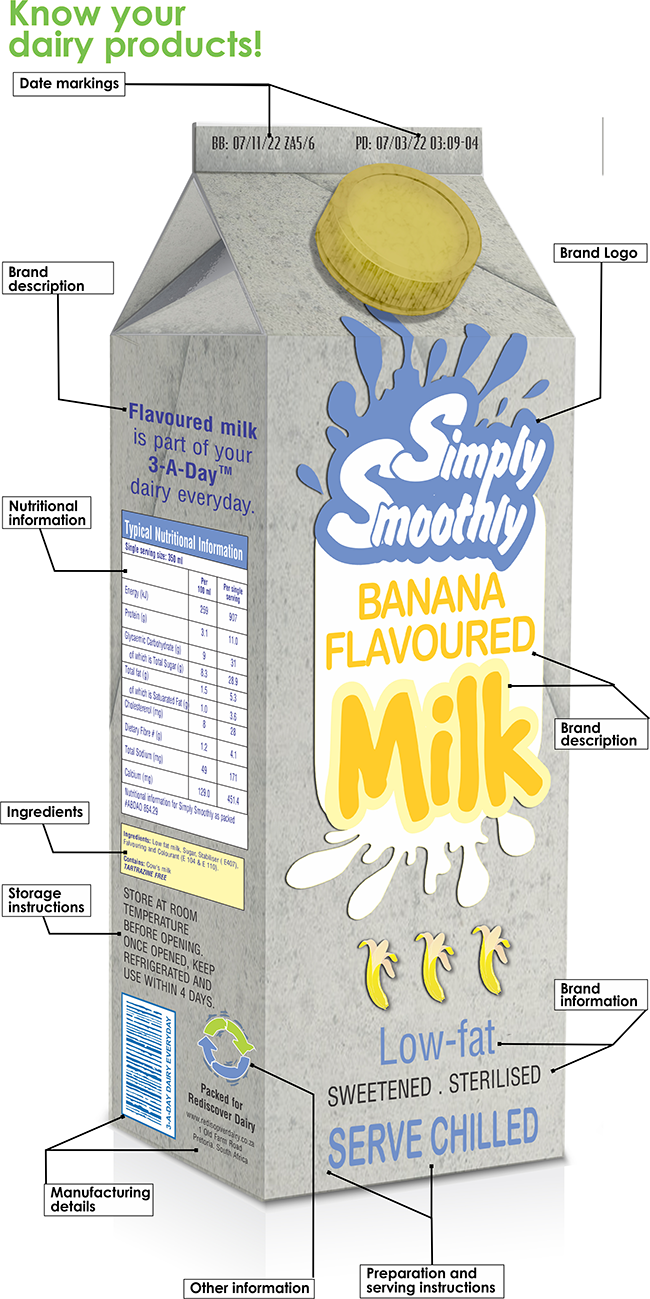 2.3.1 Reading a food label
2.3.1 Reading a food label
Knowing how to read a food label will help you to make informed choices about the products you buy. Understanding a food label also allows you to compare different products. Some information is given on the front of the package, while other types of information are given on the back of the package.
2.3.2 What information can you find on a food label?
- Product brand: The front label usually shows only the product’s name and logo, and special information the manufacturer wants to highlight to promote the product. The logo makes the product easy to recognise.
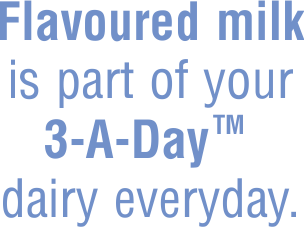
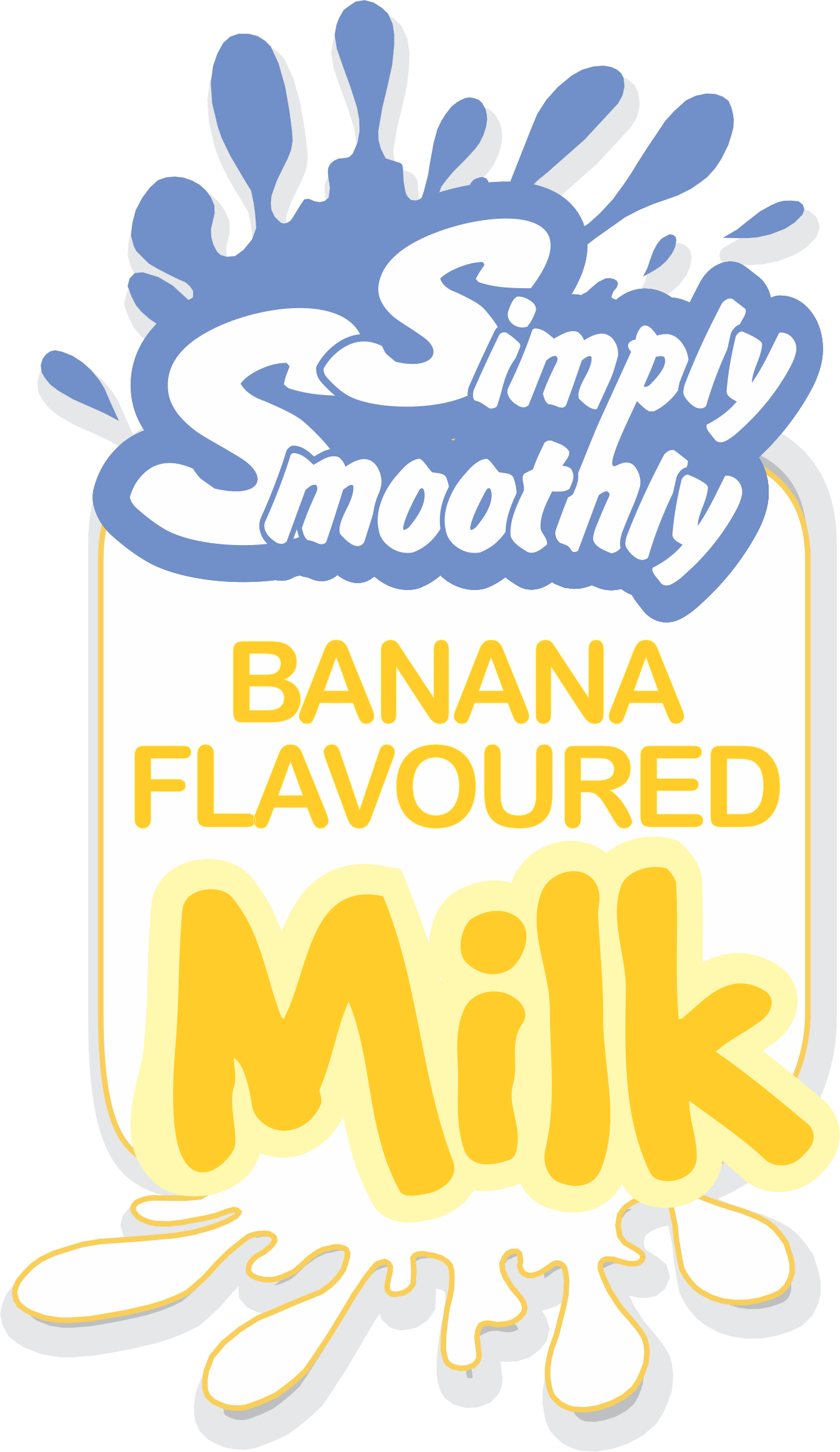

- List of ingredients: Ingredients, including additives, are listed in order of amount. The ingredient that occurs in the highest amount is listed first and the one that occurs in the lowest amount is shown last. This gives you an idea of the relative amounts of the different ingredients. Any potential allergens are specified in the ingredients list. The label of a dairy product will show cow’s milk as the first ingredient in the list. If it doesn’t say so, it’s not dairy. Cow’s milk may also be listed as an allergen.

- Typical nutritional information:
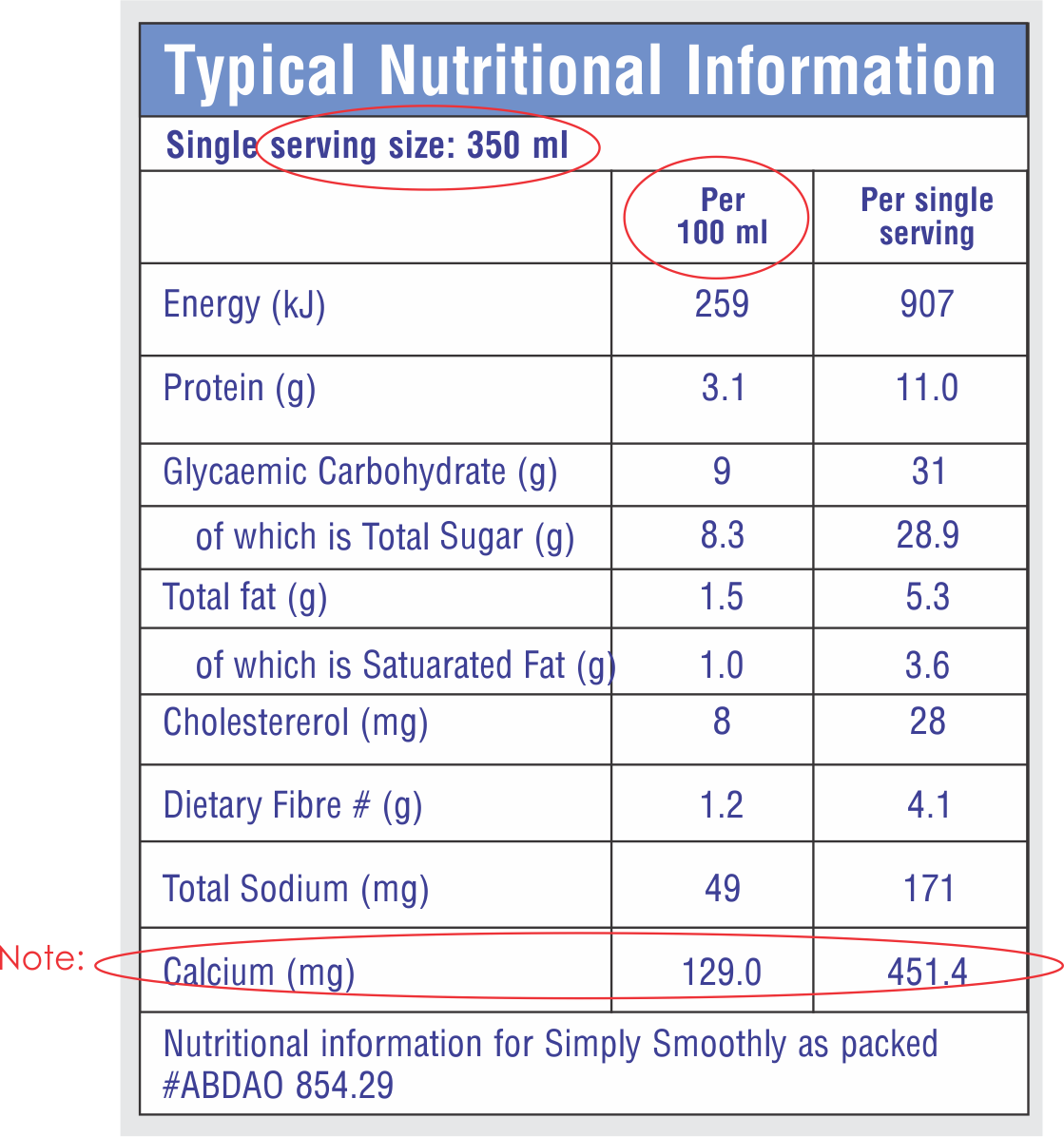 This is usually given as a table that shows the amount of energy (kJ), macronutrients (carbohydrates, protein and fats), micronutrients (vitamins and minerals) and fibre. The information is given for a single serving and per 100 g or 100 ml. Looking at the values per 100 g or 100 ml helps you to compare products. The serving size is an indication of how much you should eat at a time.
This is usually given as a table that shows the amount of energy (kJ), macronutrients (carbohydrates, protein and fats), micronutrients (vitamins and minerals) and fibre. The information is given for a single serving and per 100 g or 100 ml. Looking at the values per 100 g or 100 ml helps you to compare products. The serving size is an indication of how much you should eat at a time.
The label on a bottle of milk will show that it contains about 300 mg calcium per serving (250 ml). Drinking yoghurt contains approximately 120 mg calcium per 100 ml. - Date markings: The label must show the use-by date or best-before date.
 The use-by date tells you how long the product can be kept and be safe for use; after this date it may not be safe for consumption anymore.
The use-by date tells you how long the product can be kept and be safe for use; after this date it may not be safe for consumption anymore.- The best-before date tells you how long product can be kept and still taste at its best
Additional information can include the sell-by date and the production date.
The use-by date for long-life milk is typically six to nine months from production. For milk powder the use by date is typically eighteen months from production. The best-before date for fresh milk is typically twelve to twenty-one days after production. - Preparation and serving instructions: This tells you how to prepare the product so that it tastes at its best and is safe to eat. Typically, the information will tell you at which temperature and for how long to heat or cook the food, how to mix different ingredients or suggest the best way to serve the food in an attractive way. Most milk and dairy products are ready to enjoy just as they are. Powdered milk has to be mixed with water before drinking.

- Storage instructions:
This tells you how to store the product safely, for example in the fridge, freezer or in a cupboard. Sometimes a specific temperature range is given, for example below 5 °C. Fresh milk should always be refrigerated. Long-life milk can be stored in the cupboard while unopened, but has to be stored in the fridge once the packet is opened.
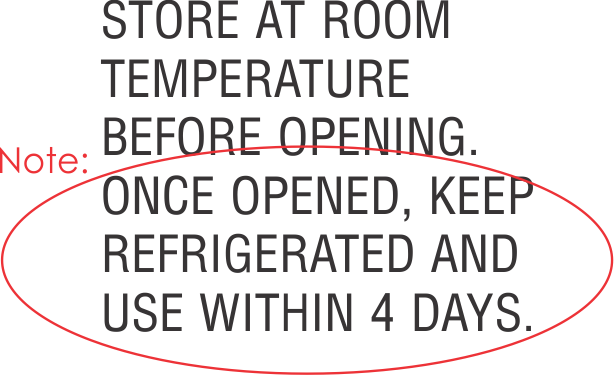
- Manufacturing details: The manufacturer’s name and physical address as well as the batch number of the product must be shown, in case the product is not of acceptable quality and has to be returned.
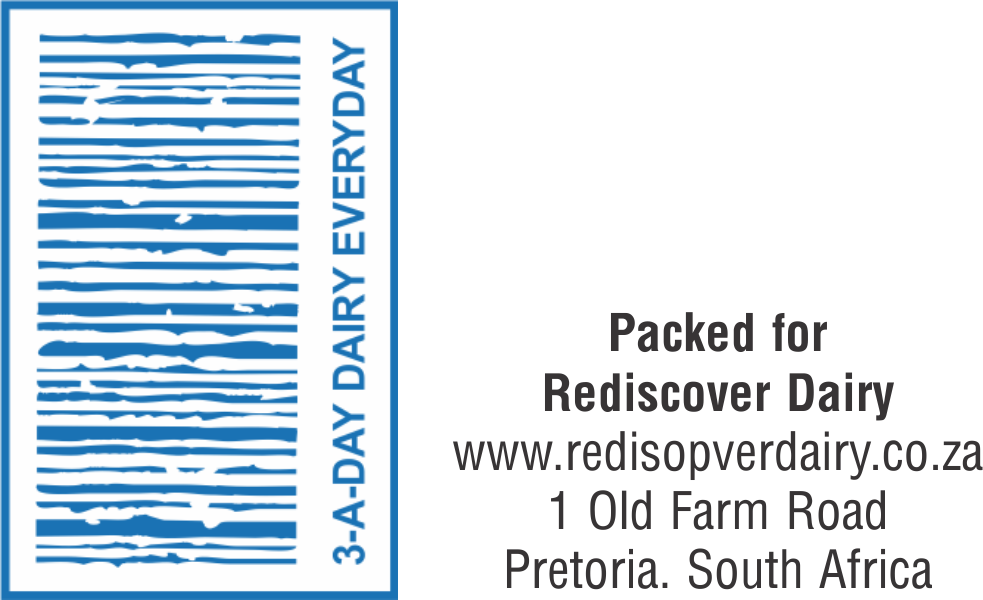
- Other information: Today, many products’ labels also show whether the packaging canbe recycled. Most plastic milk bottles and long-life milk boxes can be recycled.

2.4 What does the law say about food labelling?
The law protects consumers against false claims about food products. There are two regulations that apply to labelling dairy products:
- Regulations relating to the labelling and advertising of foodstuff, R.146 of the Foodstuffs, Cosmetics and Disinfectants Act of 1972. This regulation was updated in March 2012. It stipulates that:
- the information on the label must be in a standard format, making product comparison simpler
- misleading descriptions are not allowed, giving consumers more reliable information
- all claims must be supported by nutritional information, so consumers can confirm claims before selecting a product
- specifies the permissible claims and statements that are allowed on food
- food must be analysed for nutritional content in an approved laboratory
- additives and allergens must be clearly indicated to help consumers make informed decisions.
- Dairy Regulation R.1510 of the Agricultural Product Standards act of 1990: This regulation specifies the compositional standards and the allowable amounts of additives or other substances used in preparing a dairy product, and how products are classified. This regulation means that consumers can be sure that the labels of dairy products give trustworthy information.
 The Dairy Standard Agency (DSA) is a registered non-profit company (NPC) in terms of the Companies Act, 2008 (Act 71 of 2008). The primary objective of the DSA is to promote the quality of milk and other dairy products in the interest of the industry and the consumer. The DSA serves as an objective organisation, which acts according to scientific information and functions independent of commercial interests that may affect the organisation’s actions.
The Dairy Standard Agency (DSA) is a registered non-profit company (NPC) in terms of the Companies Act, 2008 (Act 71 of 2008). The primary objective of the DSA is to promote the quality of milk and other dairy products in the interest of the industry and the consumer. The DSA serves as an objective organisation, which acts according to scientific information and functions independent of commercial interests that may affect the organisation’s actions.
The DSA’s activities as determined by its mandate and documented in the company’s Memorandum of Incorporation namely:
- Monitoring of milk and other dairy products;
- Communication with industry and other stakeholders;
- Support service to the dairy industry and other stakeholders.
The dairy industry as is the case with any other food industry is exposed to various risks that could influence its market share. Whether it is the market forces, the environment, power of the media, increased consumer awareness and or customer requirements, all efforts are made by industry to influence those aspects that eventually could have a negative impact on the sustainability of the dairy value chain as well as have a negative impact on consumerism.
In its drive to promote the quality of dairy products, DSA is fundamentally informed and guided by scientific knowledge regarding the numerous variables relevant in respect of the quality of unprocessed milk, processed milk and the other dairy products, which include various legal and other standards, the guidance in respect of good production, manufacturing and distribution technologies leading to the identification of quality problems and measures to minimise and eliminate problems. These variables include the role and responsibilities of stakeholders in the dairy value chain, including, but not limited to feed manufacturers, milk producers, veterinary practitioners, raw material suppliers, processors, distributors, retail and the consumer. The relevant science behind improvement of dairy quality is dynamic and subject to progress. It is therefore important for the dairy industry to remain sustainable as it makes no sense to invest in new technology to support dairy production and good nutrition at the expense of substandard quality.
The task of promoting dairy quality (unprocessed milk, processed milk and the other dairy products) is multi-dimensional and requires a wide spectrum of understanding of factors influencing the dairy value chain. The different South African and international legal and voluntary standards, which include numerous good production and manufacturing standards, the various fields of scientific knowledge and scientific investigations regarding the origin and prevention of quality problems, are but some of these factors that is dealt with by the DSA. To effectively address quality (including safety) challenges of dairy in the value chain requires a strong scientific approach, focussing on the implementation of scientifically based pro-active measures rather than reactive approaches, which may result in poor risk mitigation. As much as DSA engages with government bodies regarding improvement of quality, Milk SA and DSA fully acknowledge and support the fact that law enforcement is a function of the applicable regulators of quality at all three tiers of government and not the work of the DSA.
Promoting the quality of dairy requires a strong integrated approach and knowledge of the roles of all stakeholders as well as their multi-disciplinary influence on research and development impacting on the quality (product composition and food safety) of dairy products.
The above emphasizes the sphere and expansion of the activities the DSA since its inception in 2002.
[1] The DSA’s existence is the direct result of the acceptance of a strategic approach by the organised dairy industry (Milk SA, SAMPRO and the MPO). The approach is aimed at increasing the market for milk and other dairy products, the improvement of international competitiveness of the South African dairy industry and the empowerment of previously disadvantaged people.
The Milk SA funded projects of DSA are statutory funded from levy income in terms of regulations issued by the Minister of Agriculture, Land Reform and Rural Development under the Marketing of Agricultural Products Act.”
2.4 Glossary:
additives: substances added to a food product to preserve it or improve its taste or appearance
allergens: substances that can cause an allergic reaction
best-before date: the last date by which the product will taste at its best
regulations: official rules for controlling an activity or process or the quality of a product
3. Food-related consumer issues: Dairy as part of a sustainable diet
3.1 Introduction
With concerns about environmental pressures, the world is focusing more and more on sustainable lifestyle choices. When it comes to food choices, sustainability influences not only what consumers buy but also how food is produced.
A sustainable food system:
- ensures food security for everyone
- does not compromise economic, social and environmental bases of food production
- ensures continued healthy nutrition for future generations.
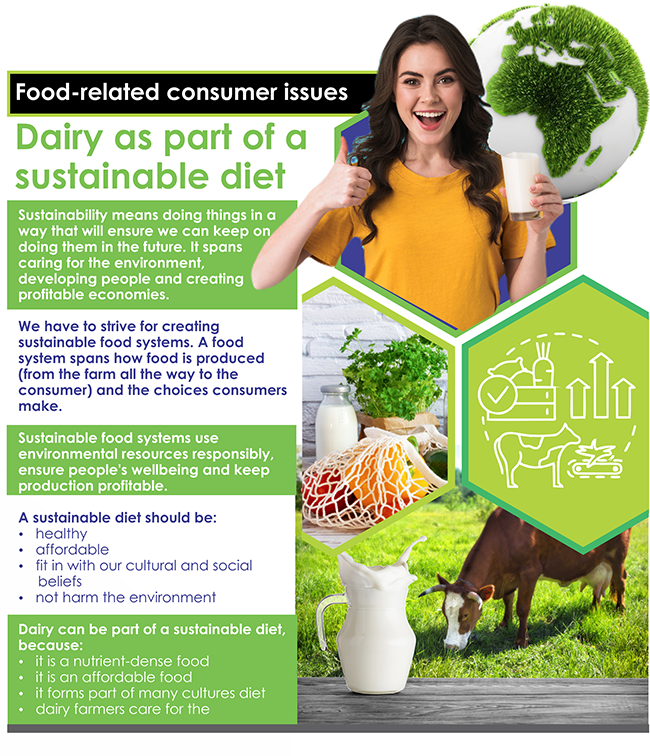
3.2 Dairy as part of a sustainable diet
What we eat should be healthy, affordable, fit in with our cultural and social beliefs and not harm the environment – all four these conditions have to be met in a sustainable diet. Dairy is a valuable food in a sustainable diet because of its nutritional value, affordability and cultural acceptability. Worldwide the dairy industry is also working hard to use environmentally sound farming practices.
3.2.1 Dairy is nutritious
Dairy products such as milk, yoghurt and cheese are nutrient dense. That means dairy provides many nutrients relative to its energy content. In fact, dairy gives more nutrients per kilojoule (protein, six minerals, four vitamins) than most high-energy foods.
Milk and dairy provide good-quality protein, which gives the body all the essential amino acids it needs to support healthy growth and repair of body tissues. It also provides carbohydrates, vitamins A, B2 and B12, and the minerals calcium, potassium, phosphorus, magnesium and zinc. Dairy is the best source of dietary calcium, which is important to build strong bones and teeth.
3.2.2 Dairy is an affordable food source
Milk and dairy products are nutrient rich and a good source of high-quality protein, yet generally costs less than other animal-derived protein food sources such as meat, poultry or fish. Although plant-based protein foods may be cheaper, they do not contain all the essential amino acids the body needs and generally have a lower protein density than animal-derived foods such as dairy.
3.2.3 Dairy is popular in many cultures
The consumption of milk from domesticated animals can be traced back 9 000 years to Anatolia, the modern-day Turkey or Middle East. From there the practice spread to Greece and the Balkans. As people’s lifestyles changed from hunting and gathering to structured agriculture, the consumption of milk and its use as a food ingredient increased. Milk is used to produce various dairy products, such as milk for drinking (available as liquid milk or in powdered form), cheese, yoghurt, butter, and whey proteins used as a food ingredient.
Many cultures enjoy traditional dairy products. In South Africa, amasi – a traditional fermented dairy product – is well loved and forms part of many South Africans’ diet. Amasi was traditionally prepared by storing unpasteurised cow’s milk in a calabash or hide sack. This allowed the milk to ferment. Today amasi is made by adding live cultures to full-cream pasteurised cow’s milk. These live cultures help the fermentation process along, which gives amasi its distinct sour taste and additional health effects.
Amasi is good for the whole family:
- The live cultures in amasi help to build a strong digestive system and keep the immune system strong
- Like other fermented milk products, amasi is generally tolerated well by people who are lactose intolerant.
- It is also a good meal replacement when your household’s meat stores are low.
3.3 Sustainable farming practices in dairy production
Each stage of food production affects the environment, because food production requires water, land and energy. This is also true in dairy farming. However, worldwide the dairy industry is working toward making dairy production more sustainable, by ensuring responsible water use, improving soil quality, using energy-efficient production methods and caring properly for cows.
The South African dairy industry actively supports national standards regulation (R1694) that focuses on the welfare of dairy cattle, by committing to treat animals ethically, caring for their wellbeing and keeping them healthy. Sustainable dairy farming means higher yields, a smaller impact on land use and water resources and lower greenhouse gas emissions.
3.4 Glossary
sustainability: the practice of living in such a way that future generations will benefit from our actions today
food system: the interconnected activities involved in producing, supplying and consuming food
sustainable diet: eating food that is healthy and produced in a way that will ensure future generations’ wellbeing
4. Practical Activity – Basic Cheesecake



